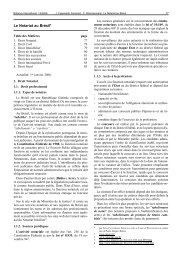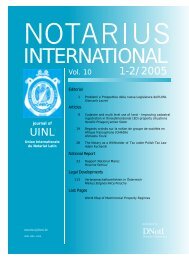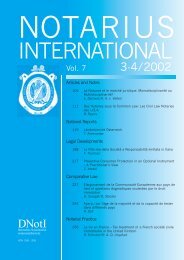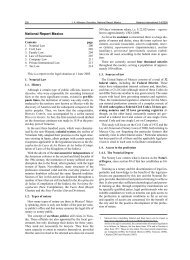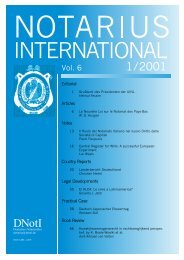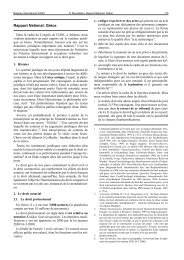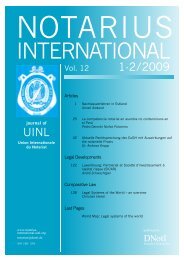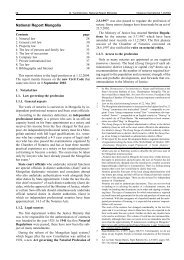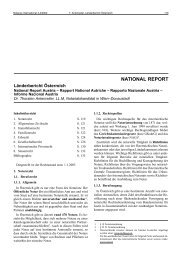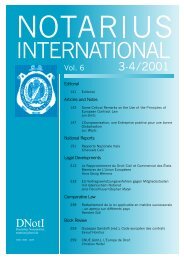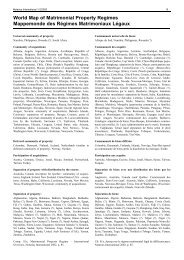You also want an ePaper? Increase the reach of your titles
YUMPU automatically turns print PDFs into web optimized ePapers that Google loves.
204 J. A. Márquez González, National Report Mexico <strong>Notarius</strong> <strong>International</strong> 3-4/<strong>2005</strong><br />
- Other titles that the law expressly orders to be registered.<br />
2.4. Contracts with property promoters<br />
In Mexico, this type of contract is partially governed by<br />
the Ley Federal de Protección al Consumidor (Federal<br />
Consumer Protection Law). Articles 73-76 of this law<br />
govern transactions involving immovable properties and<br />
provide that related acts will only be subject to this law<br />
when the party providing the property is a real-estate developer,<br />
builder, promoter or other person involved in advising<br />
and selling houses to the public that are intended<br />
for dwellings or when the consumer is granted the right to<br />
use properties through the system of time sharing in accordance<br />
with articles 64 and 65 and that such contracts<br />
must obligatorily be registered at the Federal Consumer<br />
Protection Agency. Also, the contract in question must<br />
comply with a number of minimum requirements that are<br />
governed in detail in the law (articles 73 bis and 73 ter).<br />
2.5. Property in condominium and surface area occupancy<br />
rights<br />
Property in condominium is governed in Mexico by a<br />
specific law from 1999 named the Ley de Propiedad en<br />
Condominio de Inmuebles para el Distrito Federal<br />
(LPCI) (Law of Property in Condominium of Immovable<br />
Property for the Federal District), which governs its creation,<br />
alteration, organisation, functioning, administration<br />
and termination. There are three types of condominium<br />
according to its structure: vertical, horizontal and<br />
mixed. It may be used for housing, commerce or services,<br />
industry and mixed use.<br />
The creation of the system requires a statement of will in<br />
a public deed executed before a notary. The deed creating<br />
the system of property in condominium must be entered at<br />
the public registry after the relevant fees have been paid.<br />
Surface area occupancy rights are not expressly mentioned<br />
in the CCFD.<br />
2.6. Restricted real rights on immovable property<br />
The real rights enshrined in our legislation are those of<br />
ownership, co-ownership, usufruct, use, habitation, easement,<br />
pledge and mortgage.<br />
The right of ownership is contemplated in articles 830-<br />
937 of the CCFD in relation to the provisions contained<br />
in article 27 of the Political Constitution of the United<br />
States of Mexico (PCUSM):<br />
Land and water within the bounds of Mexican national<br />
territory are originally owned by the nation, which had<br />
and has the right to transfer ownership of them to private<br />
individuals, thus constituting private property. Joint stock<br />
companies may own rural land, though only the area that<br />
is necessary to fulfil their object. The law containing the<br />
regulations on this matter will regulate the capital structure<br />
and minimum number of shareholders of these companies<br />
so that the land owned by the company does not<br />
exceed the limits on pequeña propiedad (small agrarian<br />
private ownership parcels) in relation to each shareholder.<br />
Likewise, the law will state the conditions for foreign<br />
participation in those companies.<br />
Another type of restriction relates to the acquisition of<br />
rural land by joint stock companies (only to the area that<br />
is necessary to fulfil their object) and to the creation of<br />
family property (which cannot be alienated and cannot be<br />
attached, as stated in the same article 27, section XVII of<br />
the PCUSM).<br />
With regard to the right of pledge, we must clarify that<br />
a recent reform in 2003 amended the General Law on<br />
Credit instruments and Transactions, the Commercial<br />
Code, the Law on Credit Institutions, the Law on the Securities<br />
Market, the General Law on Mutual Insurance<br />
Institutions and Companies, the Federal Law on Deposit<br />
Institutions and the General Law on Auxiliary Credit Organisations<br />
and Activities to allow pledges without transfer<br />
of ownership and other types of guarantees, among<br />
other things.<br />
3. Family law<br />
The legal system relating to the family is included in<br />
the Civil Code, except in the cases of the states of Hidalgo<br />
and Zacatecas. In fact, these two federal states have<br />
separate codes of family law.<br />
3.1. Matrimonial law<br />
Some codes define the institution of marriage. These<br />
include the civil code of Veracruz, article 75 of which<br />
states as follows: “Marriage is a union between one single<br />
man and one single woman who live together to carry<br />
out the essential purposes of the family as a social and<br />
civil institution”. In the case of the CCFD, the institution<br />
is not defined and the code only contains the clarification<br />
that marriage must take place before the officials established<br />
by law and observing the formalities that the law<br />
requires.<br />
Neither is it common for civil codes to define the concept<br />
of the family. Nevertheless, the civil codes of the<br />
states of Aguascalientes (747) and Guerrero (article 374),<br />
the Family Code of Hidalgo (article 340), the civil codes<br />
of Jalisco (article 778), Michoacán (article 120), Querétaro<br />
(article 135), Quintana Roo (article 1190), Tamaulipas<br />
(article 663) and the Family Code of Zacatecas (3rd<br />
article) contain dogma defining the concept.<br />
Some civil codes classify marriage as a social and civil<br />
institution (Baja California, Hidalgo, Jalisco, Querétaro,<br />
Veracruz), whereas others simply state that it is a contract<br />
(Federal District, Oaxaca and Puebla). We should point<br />
out that article 120 of the Civil Code of Morelos states<br />
that, “The Morelian family is a natural grouping...”.<br />
3.2. Celebration of marriage<br />
The capacity to enter into matrimony. Civil legislation<br />
establishes a minimum age for the bride and bridegroom.<br />
The bridegroom must be at least sixteen years of age and<br />
the bride must be at least fourteen years of age and this<br />
provision coincides in almost all the civil codes in the<br />
Mexican republic.<br />
The states of Puebla and Jalisco impose the same minimum<br />
age on the bride and the bridegroom – sixteen<br />
years of age (articles 300 and 260, respectively), while<br />
the Federal Code of Hidalgo requires a minimum age of



